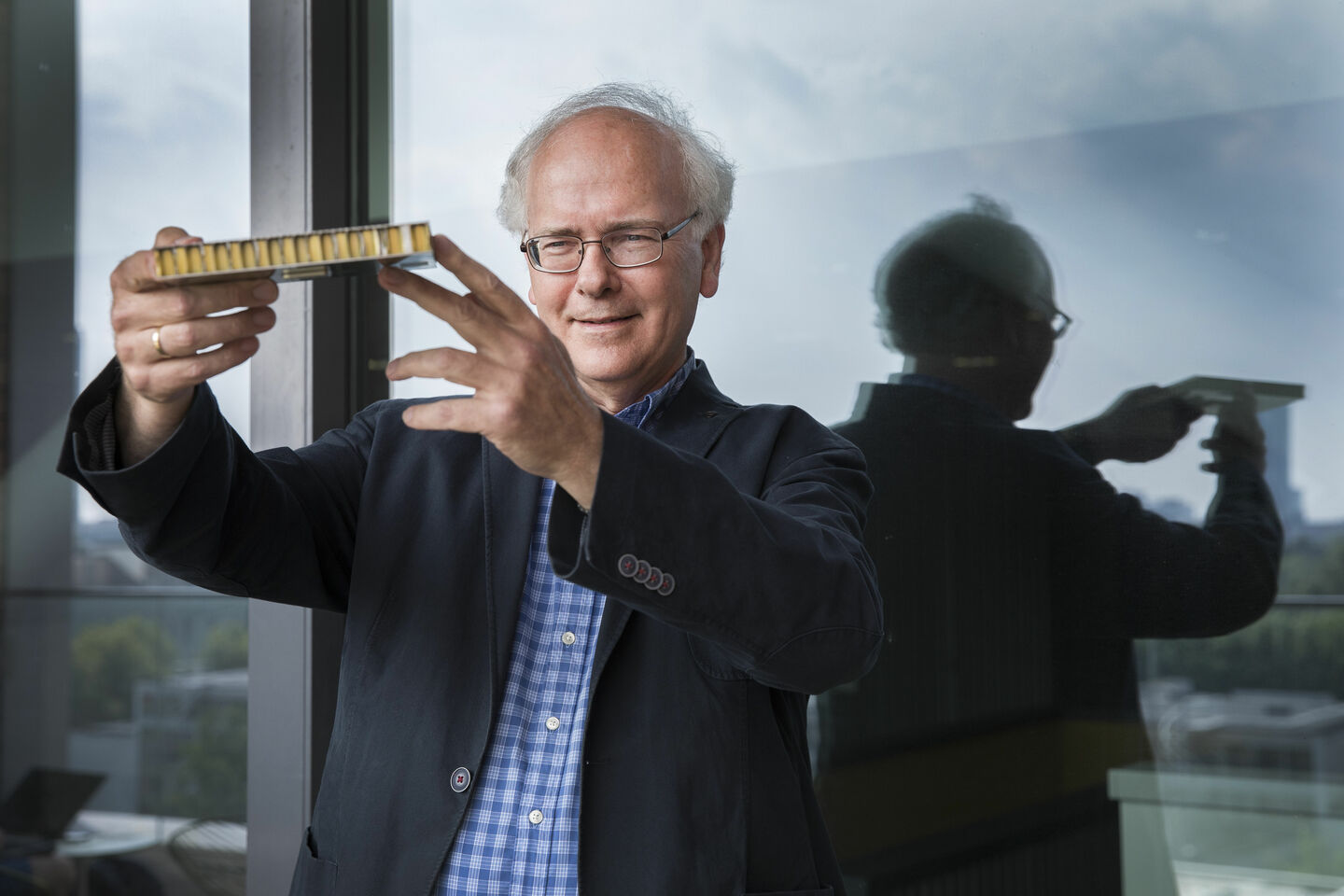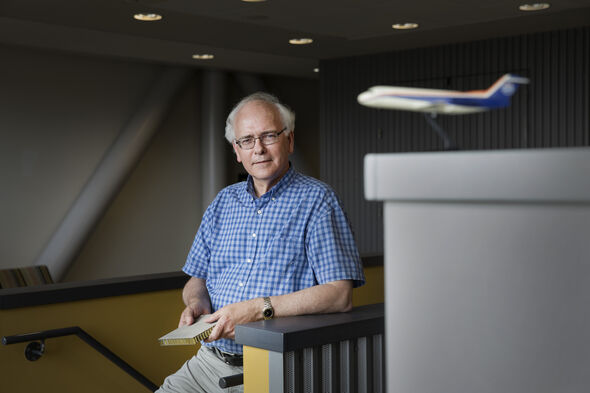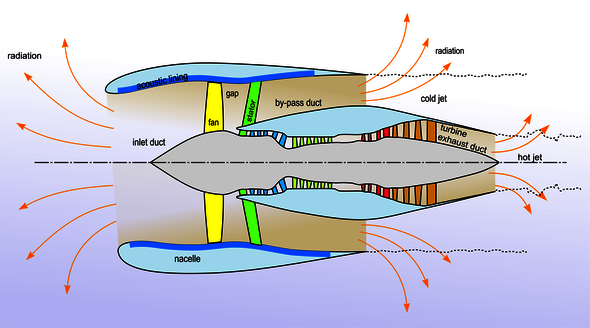
The quest for quieter engines
The noise of aircraft engines has decreased by more than 30 decibels since the 1950s, and this is work terrain of aero-acousticians like Sjoerd Rienstra. Formally, the mathematician has retired, but next month he will receive the prestigious CEAS European Aeroacoustics Award for his special services. Friday afternoon, May 25, Rienstra will be lauded for his work during a festive symposium.
A scientific career does not come to a grinding halt as soon as you start drawing your pension, so Sjoerd Rienstra can still regularly be found at his office in MetaForum. Science is a calling of sorts, he says. “Friends often ask me when exactly I'll be stopping, but for now I'm still supervising a couple of students and a PhD candidate, I'm on the science committee of the Netherlands Aerospace Centre (NLR), and a member of the CEAS Aeroacoustics Specialists’ Committee, and I still fly to Hong Kong regularly for a big project over there.”
The honor of collecting the European Aeroacoustics Award next month he refers to as “a really fine pat on the back. You don't get to hear every day that you're doing good work, so you never know whether what you're doing is actually appreciated.” Still, it would have been nice for his career if he had received the award before he retired, he remarks. “You can use an award like that to good effect on grant applications.”
In the Netherlands these grants are thin on the ground in his chosen field. Aeroacoustics is the science that studies the sound that arises due to - and interacts with - flowing air, and has traditionally been closely associated with research on the noise of aircraft engines. In fact, the emergence of the field is marked by the publication by Britain's James Lighthill of a work on the din produced by jet engines. At conferences on aeroacoustics, says Rienstra, aircraft are still the chief topic of discussion.
While aeroacoustics has not been a priority in the Netherlands since the bankruptcy of aircraft manufacturer Fokker, the situation is different internationally. Accordingly, over the past few decades Rienstra has been involved mainly in large European projects with input from England, Germany and France. “Over there they still have large engine makers like Rolls-Royce and aircraft manufacturers like Airbus,” explains the mathematician. “It costs roughly a billion euros to develop a new engine, just as much as the rest of the aircraft. So, of course, you don't want the aircraft to fail any tests on account of the noise standards.” After safety, noise is the most important criterion for an engine, he says, ahead even of efficiency.
It costs roughly a billion euros to develop a new engine; you don't want the aircraft to fail any tests on account of the noise standards
Having studied mathematics at Utrecht, Rienstra gained his doctorate at TU/e with a study of the interaction between noise, air flow and vortices. His supervisor at Applied Physics was supposed to be the then rector magnificus, Gerrit Vossers, who passed away in 2014. “He was on the verge of stepping down as rector, but because no one wanted to succeed him, he had to stay on. Luckily I was able to get David Crighton of the University of Leeds as my co-supervisor – we got on well right from the start.”
With his doctorate under his belt, Rienstra left for the NLR, then the National Aerospace Laboratory. There he became an expert in the propulsion aerodynamics of aircraft engines. An expertise highly sought after by aircraft manufacturer Fokker. “They didn't make any engines themselves, they bought them from Rolls-Royce. To negotiate from a strong position, they needed knowledge in house of how the engines worked.”
Still feeling the pull of research, Rienstra moved to Radboud University. After two years in Nijmegen, he joined the TU/e's Department of Mathematics and Computer Science in 1988. In this period he was no longer occupied with aeroacoustics, that would have been an odd choice in the world of Dutch research. Still, the subject did not lose its appeal, he says. “I enjoyed it, and seemed to have a knack for it. That happens sometimes – one person is good at soccer, the other at aeroacoustics.”
E-book
Rienstra started publishing again on the subject, and in 1992 together with colleague Mico Hirschberg of Applied Physics he wrote an e-book, which developed out of lecture notes of sorts for a course on aeroacoustics: An Introduction to Acoustics. “That book was mentioned several times in the jury report for the European Aeroacoustics Award, and it is much-cited. It is freely available on internet, and is continually being improved and extended. I also think it is special because it works from a solid mathematical basis. And indeed, by its nature, aeroacoustics is very mathematical, acoustics in general is much less so.”
Mathematical analyses are necessary in aeroacoustics, explains the expert, because you can only take measurements at actual size – unlike in ‘ordinary’ aerodynamics, where it is often possible to place scale models in wind tunnels. “In the Netherlands the only place you can do measurements on aircraft engines is in the German-Dutch Wind Tunnel in the North-East Polder. That costs about a hundred thousand euros a day. So you really need mathematical models.”
The founder of the field James Lighthill, as mentioned above, demonstrated in 1952 that the amount of sound produced by the jet of a jet engine is proportional to the eighth power of the air speed. Given that you can produce this same thrust by applying a lower air flow velocity in a channel with a wider diameter, you can reduce the jet noise by allowing some of the air to flow through a bypass. “The use of ever higher bypass ratios decreased the noise of the engines by some 30 decibels by the year 2000,” says Rienstra. “To put that into perspective, that is the full dynamic range of vinyl records: the difference between the loudest and quietest sound that you can record on vinyl.”
Personally, Rienstra has worked chiefly on the mathematics of various types of acoustic lining for the inside of aircraft engines. Because the right lining, appropriate to the noise of the fan that sucks in air (see visual), also helps dampen the aircraft noise. The illustration on his personal website that he uses to explain this has become a classic in the field. “I see it pop up a couple of times at every conference I attend. There simply aren't that many good illustrations of aircraft engines, because the manufacturers publish as little as possible for reasons of competition. That's why I once thought I'd make something myself, and it has clearly become popular.”
Owl wings
Aircraft have clearly become a whole lot quieter, but slowly the aero-acousticians and aircraft manufacturers are reaching new boundaries. “Much of the noise that is produced during landing is not engine noise,” explains Rienstra. “By then the engine is almost shut down; but to compensate for the decreasing lift, the surface area of the wings is increased by extending their slats and flaps. At a certain point, these start making more of a racket than the engine - think of that swoshing noise produced by wind turbine blades.”
The next step may be to shape the wings so that the formation of vortices– which cause the noise – is prevented. “Owls fly almost soundlessly thanks to their particular pattern of feathers. Perhaps we can learn from them.” A nice task for the next generation of aero-acousticians.
More information about the festive symposium for Sjoerd Rienstra can be found here.



Discussion